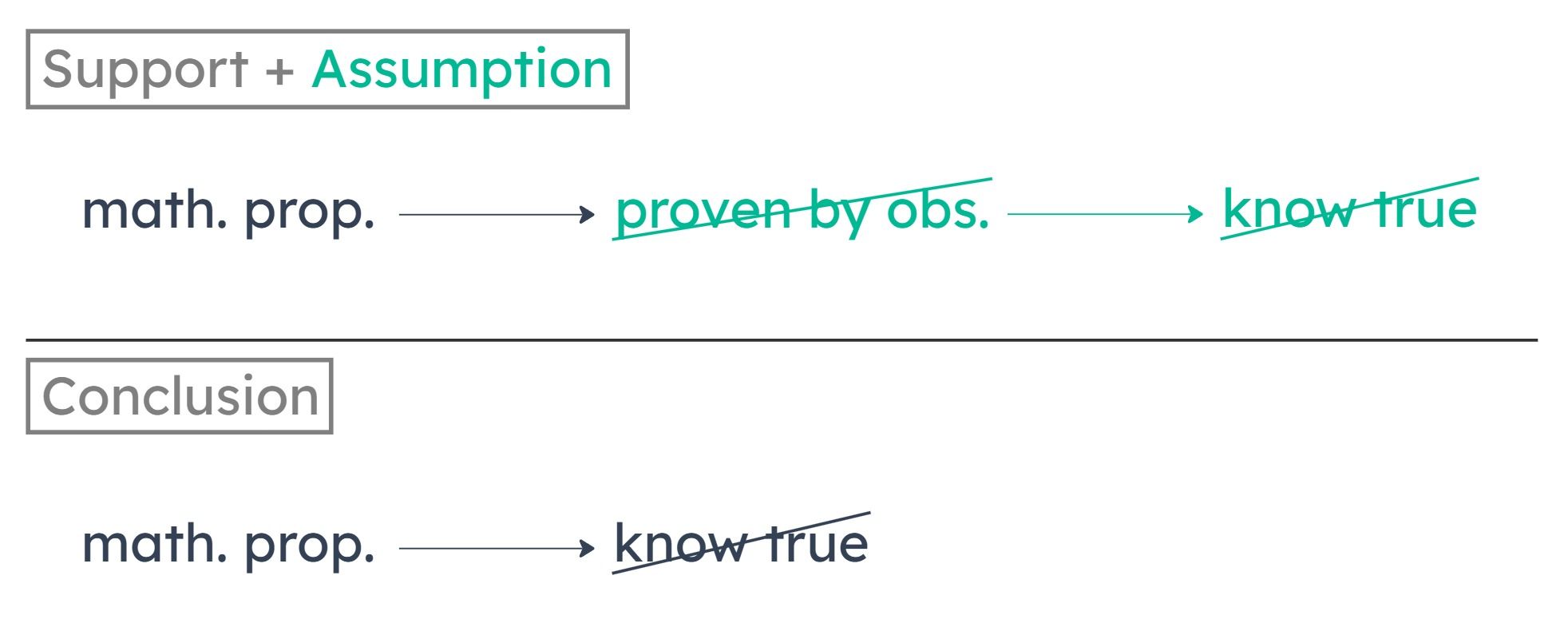A
It limits the application of the argument to a part of the problem.
B
It suggests that the primary cause of homelessness is lack of available housing.
C
It is offered as evidence crucial to the conclusion.
D
It expresses the conclusion to be argued for.
E
It suggests a possible solution to the problem of homelessness.
Note: At 0:34, J.Y. said that "no" was "negate sufficient" when he meant to say "negate necessary".

To make the argument valid, we want to know that if something is impossible to prove true by observation, then it is impossible to know is true. In other words, we want to know that in order to know that something is true, we must be able to prove it true through observation.
A
Only propositions that can be proven true can be known to be true.
B
Observation alone cannot be used to prove the truth of any proposition.
C
If a proposition can be proven true by observation, then it can be known to be true.
D
Knowing a proposition to be true is impossible only if it cannot be proven true by observation.
E
Knowing a proposition to be true requires proving it true by observation.

Note: At 0:34, J.Y. said that "no" was "negate sufficient" when he meant to say "negate necessary".
Biologist: Some speculate that the unusually high frequency of small goats found in island populations is a response to evolutionary pressure to increase the number of goats so as to ensure a diverse gene pool. However, only the reproductive success of a trait influences its frequency in a population. So, the only kind of evolutionary pressure that can reduce the average size of the members of a goat population is that resulting from small goats achieving greater reproductive success than their larger cousins.
Summary
The biologist refutes the view that the high frequency of small goats on islands is due to evolutionary pressure to increase the number of goats. Why is this wrong? The only way a trait can increase in frequency is through reproductive success, Therefore, the only evolutionary pressure that could cause this phenomenon is small goats achieving greater reproductive success.
Strongly Supported Conclusions
The biologist considers the speculations she refers to to be incorrect.
Small goats have greater reproductive success in island populations than larger goats.
Ensuring a diverse gene pool does not qualify as evolutionary pressure.
A
The evolutionary pressure to ensure a diverse gene pool could have the effect of increasing the frequency of a gene for small size.
Anti-supported. The biologist refutes this point. She says only reproductive success would qualify as evolutionary pressure.
B
The unusual frequency of small goats in island populations is not a result of the greater reproductive success small goats possess when space is limited.
Anti-supported. The biologist claims that the only thing that can reduce the average size of the population is greater reproductive success for small goats. This may or may not be due to the small space.
C
Contrary to what some believe, large goats achieve greater reproductive success than small goats even when space is limited.
Unsupported. There is no support for the actual reproductive success rates by goat size. The biologist is advocating the point that the smaller goats must achieve greater reproductive success in order to decrease the average size of the goats.
D
The evolutionary pressure to ensure a diverse gene pool does not have the effect of increasing the frequency of a gene for small size.
Strongly supported. The author dismisses this claim on the grounds that it does not impact reproductive success, the only way to influence frequency. Therefore, ensuring a diverse gene pool cannot have the effect of increasing the frequency of the gene for small size.
E
A diverse gene pool cannot be achieved in a goat population unless the average size of its members is reduced.
Unsupported. There is no information as to how a diverse gene pool can or cannot be achieved. That was only part of a theory that was dismissed.
Notice to subscribers: In order for us to provide you with efficient and reliable newspaper service, please note the following policies. You will be billed for home delivery every four weeks, in advance. If you do not receive delivery, call us promptly to receive a replacement copy. Credit can be given only if the missed copy is reported to us within twenty-four hours and only if a replacement copy is unavailable. Request for temporary nondelivery must be made at least three days prior to the first day on which delivery is to stop. No subscription will be canceled unless the subscriber explicitly requests the cancellation beforehand and in writing.
The Daily Gazette
Summary
The stimulus can be diagrammed as follows:

Notable Valid Inferences
This is a MBT Except question. For this question, all the wrong answers must be true (i.e., the denials can be justified), and the right answer must be false (i.e., the denial cannot be justified). We are looking for an answer choice that describes a subscriber who fulfilled all the requirements to be granted their request but was still denied.
A
Mr. Rathanan did not send in his advance payment two weeks ago; he states that his inaction was intended as cancellation and requests that he not be charged for the past two weeks of delivery of The Daily Gazette.
This denial is justified. A written request must be made beforehand to cancel a subscription, and Mr. Rathanan did not fulfill this requirement. We can also see this relationship by taking the contrapositive of the last conditional statement in the stimulus.
B
Dr. Broder called The Daily Gazette Monday morning to report that her Sunday edition had not been delivered; she requests credit instead of the offered replacement copy.
This denial is justified. A credit will only be offered if a replacement copy is unavailable. Because a replacement copy was available, a credit cannot be offered. We can also see this relationship by taking the contrapositive of the second conditional statement in the stimulus.
C
The Daily Gazette was delivered to Ms. Herrera during her one-week vacation even though she called on a Wednesday to stop delivery the following Monday for the entire week; she requests credit for the full week’s delivery.
This denial is not justified. Ms. Herrera requested temporary nondelivery more than three days before the first day she wanted delivery to stop, fulfilling the requirements for requesting temporary nondelivery. Based on the stimulus, there is no reason for her claim to be denied.
D
Although Ms. Jackson telephoned The Daily Gazette at the beginning of June requesting that her subscription be canceled on June 30, delivery was continued until July 3 when she called to complain; she requests that she not be charged for the papers delivered in July.
While Ms. Jackson did request her subscription be cancelled in advance, she did not make this request in writing. Therefore, the denial is justified. We can also see this relationship by taking the contrapositive of the last conditional statement in the stimulus.
E
Ms. Silverman was out of town on Sunday and Monday and when she returned on Tuesday she found that her Sunday edition had not been delivered; she called The Daily Gazette on Tuesday afternoon requesting credit for the undelivered copy.
This denial is justified. As we can see from the second conditional statement in the stimulus, a missing copy should be reported within 24 hours. Ms. Silverman failed to meet this condition, which implies the denial is justified.
Numismatist: In medieval Spain, most gold coins were minted from gold mined in West Africa, in the area that is now Senegal. The gold mined in this region was the purest known. Its gold content of 92 percent allowed coins to be minted without refining the gold, and indeed coins minted from this source of gold can be recognized because they have that gold content. The mints could refine gold and produced other kinds of coins that had much purer gold content, but the Senegalese gold was never refined.
Summary
A numismatist tells us that most medieval Spanish gold coins were made of gold mined in Senegal. The Senegalese gold was 92 percent pure, which is so pure that it was never refined further before minting the coins. Gold from other sources, however, could be refined and thus still be minted into coins with a gold content higher than the Senegalese gold.
Strongly Supported Conclusions
The strongly supported conclusions that we can find in these facts are:
Most gold coins minted in medieval Spain had a gold content of 92 percent and were made of unrefined gold.
Medieval Spanish mints were able to refine gold from a purity less than 92 percent to a purity above 92 percent.
Some coins were minted in medieval Spain with a gold content higher than 92 percent, and were made of gold that was originally less than 92 percent pure.
A
Coins minted from Senegalese gold all contained the same weight, as well as the same proportion, of gold.
This is not supported. The stimulus never indicates the weight of different coins, only the purity of the gold used to make them. We have no idea whether all coins made from Senegalese gold had the same total weight.
B
The source of some refined gold from which coins were minted was unrefined gold with a gold content of less than 92 percent.
This is strongly supported. We know that 92 percent pure Senegalese gold, the purest known, was never refined, so any refined gold coins had to come from a less-than-92-percent pure source. And the facts state that some more-than-92-percent pure (i.e. refined) coins were made.
C
Two coins could have the same monetary value even though they differed from each other in the percentage of gold they contained.
This is not supported. The facts given don’t suggest anything about the monetary value of different coins, so we just can’t say how that relates to gold percentage.
D
No gold coins were minted that had a gold content of less than 92 percent.
This is not supported. We know that some coins were minted with a gold content of 92 percent and that some were minted with an even higher gold content, but the author never indicates whether or not coins were minted with a lower gold content.
E
The only unrefined gold from which coins could be minted was Senegalese gold.
This is not supported. Just because medieval Spanish mints made coins out of unrefined Senegalese gold, that doesn’t mean they never used other unrefined gold. Maybe they had a source of 90 percent pure gold that they also didn’t refine. We just don’t know!